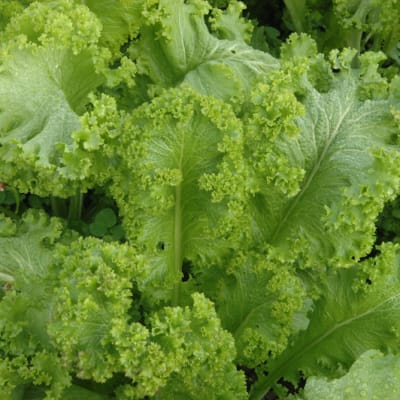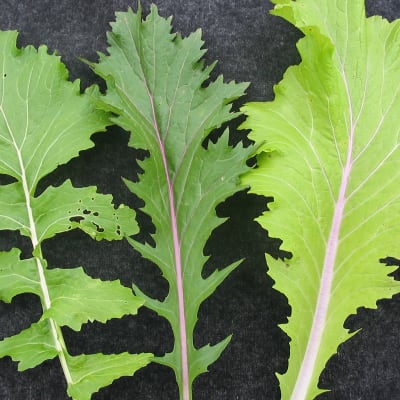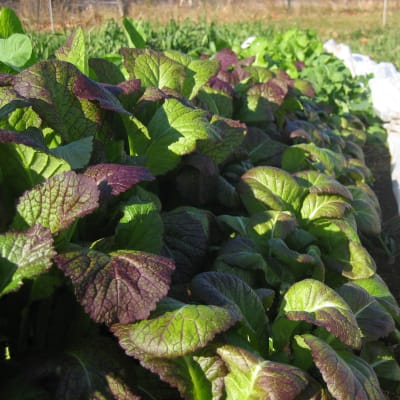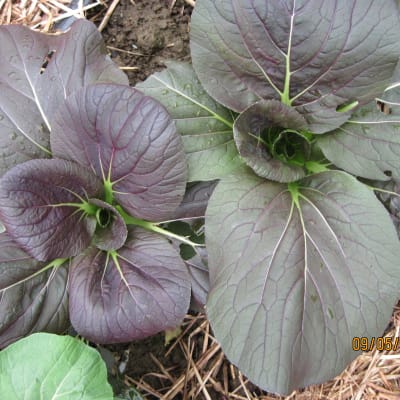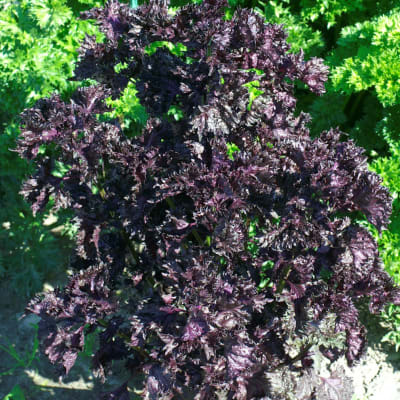You are viewing all Fedco Seeds products related to “Greens.”
Items related to "greens" in
Fedco Seeds
Results in our other divisions:
14 in Organic Growers Supply
14 in Organic Growers Supply
Brassica juncea
(47 days mesclun, 62 full size)
Open-pollinated.
Sweet succulent ribs and moderately pungent winter-hardy greens. Good for summer mesclun; excellent cut-and-come-again.
read more
Glebionis coronaria
(40 days)
Open-pollinated.
Japanese Shungiku prized for small grey-green leaves and 5" yellow flowers, both edible. Sow in spring.
read more
Brassica rapa
(37 days)
Open-pollinated.
Produces many pencil-thick deep purple flowering shoots with pleasing mild mustard flavor. Grows best in cool weather.
read more
Brassica rapa
(45 days)
Open-pollinated.
Slow-growing 8-10" deep purple rounded leaves stand beautifully, and are mild and delectable all the way through the season.
read more
Brassica rapa (pekinensis group)
(35 days)
Open-pollinated.
Loose round chartreuse leaves, flat white stems, and blossoms, all edible. Can be cut small for mesclun. Fair bolt tolerance.
read more
Brassica rapa (narinosa group)
(45 days)
Open-pollinated.
Spoon-shaped dark green leaves in compact rosettes. Very hardy. Cut-and-come-again.
read more
Brassica oleracea
(45-60 days)
F-1 hybrid.
Also called Chinese Broccoli. Grown for succulent stems, leaves and florets. Uses and flavor similar to broccoli. Tolerant to heat and cold.
read more
Brassica rapa (narinosa group)
(21 days baby, 45 days mature)
F-1 hybrid.
Mild deep green tender leaves used raw or cooked. Good season extender. Excellent tolerance to heat, cold. Cut-and-come-again.
read more
Brassica rapa
(60 days)
F-1 hybrid.
Striking purple-red 10" Chinese cabbage. A bit tricky to grow: heads are prone to internal tipburn.
read more
Brassica rapa (chinensis group)
(20 days baby, 45 days full size)
Open-pollinated.
Lettucy pale green ruffled leaves. Mild, sweet. Will re-grow after cuttings. Cold hardy.
read more
Brassica juncea
(20 days baby; 45 days mature)
Open-pollinated.
A favorite for cutting at the purple baby stage. Vibrant maroon slightly toothed leaves on lime-green stems. Good for salads or braising.
read more
Brassica juncea
(20 days baby, 40 days mature)
Open-pollinated.
Light golden-green leaves are curled and lacy, adds lift to salad mixes. Mustardy zing. Resists bolting in heat.
read more
Brassica juncea
(45 days)
Open-pollinated.
Best-adapted mustard for northern climates. Hot mustardy flavor. Will come back when cut. Slow to bolt. Can be overwintered.
read more
Brassica rapa
(40 days)
Open-pollinated.
Medium-dark green variably shaped leaves. Zingy. Excellent for salads or braised.
read more
Brassica rapa (japonica group)
(40 days)
Open-pollinated.
Japanese heirloom. Deeply cut fringed leaves on slender white stalks. For microgreens, cut-and-come-again, succession plantings and baby leaf production.
read more
Brassica juncea
(45 days)
Open-pollinated.
Purple-streaked foliage and succulent broad stems. Spicy. Used for mesclun and braising.
read more
Brassica rapa
(40 days) Open-pollinated. Frank Morton selected well-mixed breeding pools for disease resistance and particularly for pink and... read more
(40 days) Open-pollinated. Frank Morton selected well-mixed breeding pools for disease resistance and particularly for pink and... read more
Brassica juncea (integlifolia group)
(45 days)
Open-pollinated.
Japanese heirloom. Large purple-tinted savoyed leaves. Peppery flavor. Standard mesclun ingredient. Cold tolerant.
read more
Brassica juncea
(40 days)
Open-pollinated.
Bold purple-blushed delicately serrated mizuna-type leaves with sweet and spicy flavor. For spring and fall plantings. Bolts in heat.
read more
Brassica oleracea (alboglabra group)
(45 days)
Open-pollinated.
Dark green large tender leaves with just the right kind of mustardy bite. Prolific yields can be harvested at full size or as baby greens.
read more
Brassica rapa
(45 days full size; 21 baby)
Open-pollinated.
Grows in rosettes like tatsoi, but bigger, more upright with leaves less shiny and more puckered. Harvest young for salad greens or mature for braising.
read more
Brassica rapa (chinensis group)
(50 days)
Open-pollinated.
Classy pac choi with celery-like white stems and vase-shaped 15-18" tall heads. Succulent stems and tender greens.
read more
Brassica rapa (chinensis group)
(48 days)
F-1 hybrid.
Most vigorous and darkest-hued strain. Purple leaves with green veins and stems. 8-10" heads at maturity.
read more
Amaranthus hybridus
(65 days to flower, 125 days to seed)
Open-pollinated.
Is it a green vegetable? An ornamental? A gluten-free grain? Why, yes! No wonder Amaranth was sacred in pre-Columbian Mexico.
read more
Amaranthus tricolor
(120 days)
Open-pollinated.
Very red Jamaican traditional green for Callaloo stew. Beautiful tricolor blaze makes it ornamental as well.
read more
Eruca sativa
(47 days)
Open-pollinated.
Musky greens, certified organic. Cold tolerant, great for early spring, late fall, over-wintering. Eat the flowers if you miss some of the greens.
read more
Eruca sativa
(21 days baby, 35 days mature)
Open-pollinated.
Profuse basal growth. Dense clusters of tasty lush leaves. Grows well in hot and cool seasons.
read more
Eruca sativa
(44 days)
Open-pollinated.
Cross of two European heirlooms and selected for vigor and cold hardiness. Turns purple when it freezes. Full of flavor.
read more
Diplotaxis erucoides
(21 days baby, 50 days mature)
Open-pollinated.
Wild Arugula. Deeply lobed dark green narrow leaves. Excellent for cold-season salads, but also shows good summer endurance.
read more
Beta vulgaris
(55 days for bunching, 35–40 days baby leaf )
Open-pollinated.
Very dark lush green fully savoyed leaf, brilliant red contrasting stalk. Excellent regrowth for multiple harvests.
read more
Beta vulgaris
(56 days)
Open-pollinated.
Gold, yellow, orange and pink stems, midribs and veins. Tender dark green to bronze leaves with mild chard flavor.
read more
Beta vulgaris
(50 days)
Open-pollinated.
Standard broad white stems and dark green savoyed leaves with white veins.
read more
Beta vulgaris
(56 days)
Open-pollinated.
Heirloom. Large light green semi-savoyed leaves contrast with bright yellow stems and veins.
read more
Beta vulgaris
(55 days)
Open-pollinated.
Tender smooth leaves, thin stems, spinach-like flavor. Lasts through summer into fall. Withstands some frosts.
read more
Beta vulgaris
(59 days)
Open-pollinated.
Heirloom. Crimson stalks and dark green leaves. Hardy.
read more
Beta vulgaris
(60 days)
Open-pollinated.
Clear rich red stems contrast deep green savoy leaves. Good bolt resistance.
read more
Beta vulgaris
(56 full size; 30 days baby leaf)
Open-pollinated.
Much like Fordhook, except it’s more compact, deeply savoyed, more uniform and with a narrower stem. Long harvest window.
read more
Cichorium intybus
(60 days)
Open-pollinated.
Savory Italian chicory with deeply toothed red-veined leaves. Best in cool weather, can become bitter in heat.
read more
Cichorium intybus
(80 days)
Open-pollinated.
Heirloom. 1' tall large tight chicory with light green leaves. Very mild flavor. Stores well.
read more
Cichorium intybus
(80 days)
Open-pollinated.
Italian heirloom grown for its fused stems which form a swollen bulb. Sweet stalks eaten in salad or cooked.
read more
Cichorium endivia
(45 days) Open-pollinated. Developed by Wild Garden Seed out of their Chicendive project, originally a cross of chicory and... read more
(45 days) Open-pollinated. Developed by Wild Garden Seed out of their Chicendive project, originally a cross of chicory and... read more
Cichorium endivia
(85 days)
Open-pollinated.
Also known as Escarole. Smooth broad green outer leaves with creamy yellow closely bunched center leaves. Especially good as a fall crop; tolerates frost under row cover.
read more
Cichorium endivia
(42 days)
Open-pollinated.
French heirloom. Large frizzy sweet endive with very fine ribs. For late spring and early summer harvests.
read more
Open-pollinated.
Five or more kinds chosen from among arugulas, beets, chards, chervil, mustards, orachs, purslane, and kales. All organic, exact components vary.
read more
Grow to mix with your lettuces for more interest in your salad bowl. Or use for braising greens mix.
read more
Rumex acetosa
(60 days)
Open-pollinated.
Thick sword-shaped lemony-flavored leaves picked when young and tender. A special treat in early spring. Perennial hardy to Z3.
read more
Hablitzia tamnoides
(45 days)
Open-pollinated.
Perennial spinach-like green. Hardy vine from the Caucasus grows 6-9' long for 2-3 months beginning very early spring. Heart-shaped attractive leaves.
read more
Blitum bonus-henricus
Open-pollinated.
Heirloom perennial green and ancient European potherb. Eat shoots like asparagus; use leaves like spinach.
read more
Bunias orientalis
Open-pollinated.
Perennial, Zones 4-8. Tender spicy mustard greens and florets for stir-frying. Drought-tolerant with a deep taproot.
read more
Nasturtium officinale
Open-pollinated.
Perennial hardy to Z4. Tasty green likes full sun and soggy conditions. Use in salads and soups.
read more
Nasturtium officinale
(60 days) Open-pollinated. Perennial to Zone 4, native to Europe. Start seeds indoors and transplant to cold frame, keeping... read more
(60 days) Open-pollinated. Perennial to Zone 4, native to Europe. Start seeds indoors and transplant to cold frame, keeping... read more
Cichorium intybus
(85 days)
Open-pollinated.
Uniform round Chioggia-type with deep burgundy red heads.
read more
Cichorium intybus
(80 days)
Open-pollinated.
White-veined leaves turn from green to variegated burgundy red in cool weather. Romaine-shaped heads. Best for fall crops.
read more
Atriplex hortensis
(38 days) Open-pollinated. In his Wild Garden Seed catalog, originator Frank Morton calls it “mountain spinach for merry... read more
(38 days) Open-pollinated. In his Wild Garden Seed catalog, originator Frank Morton calls it “mountain spinach for merry... read more
Portulaca oleracea var. sativa
(50 days)
Open-pollinated.
Golden-green leaves with succulent texture and mildly acerbic flavor. Ideal addition to mesclun.
read more
Valerianella locusta
(60 days)
Open-pollinated.
Heirloom. Vigorous large-leaf type of staple salad green. Best for sowing in spring for early summer harvest.
read more
Tetragonia tetragonioides
(52 days)
Open-pollinated.
New Zealand native plant. Spinach-like green stands well in the heat of summer.
read more
Valerianella locusta
(45 days)
Open-pollinated.
Very cold-hardy small-seeded small-leaved strain of this winter staple salad green. Can be overwintered.
read more
Lepidium sativum
(30 days)
Open-pollinated.
Broad leaves are extremely ruffled, wrinkled and savoyed. Spicy, tangy and sweet. Good in salad mix and bunched for market.
read more
Anthriscus cerefolium
(60 days to full maturity)
Open-pollinated.
Flavorful lacy leaves for mesclun or microgreens. Slow-bolting.
read more
Petroselinum crispum
(75 days)
Open-pollinated.
Double-curled type with long upright stiff stems. Holds color all season, tolerates heat and repeated cuttings.
read more
Petroselinum crispum
(70 days)
Open-pollinated.
Italian heirloom. Flat-leaved parsley with good early seedling vigor and rich sweet flavor. Grows to 1' tall.
read more
Petroselinum crispum
(70 days)
Open-pollinated.
Italian heirloom. Flat-leaved parsley with good early seedling vigor and rich sweet flavor. Grows to 1' tall.
read more
Petroselinum crispum
(75 days)
Open-pollinated.
Dense triple-curled medium-green parsley. Slow to bolt, prolific, hardy. Delicious stems.
read more
Petroselinum crispum
(78 days)
Open-pollinated.
Smooth and shiny large wide dark green leaves. Upright form with vigorous growth.
read more
Raphanus sativus var. caudatus
(50 days)
Open-pollinated.
Asian heirloom, Specialty. Grown for its immature purple-green pungent seed pods. Harvest young for best quality.
read more


















